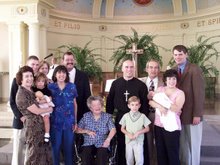NOTE: As I type this, I am in Klagetoh, AZ, deep in the heart of the Navajo Nation. I'm here for about 10 days, visiting the Brothers out here and retreating in this sacred land. I can't post pictures at the moment because the dial-up Internet access would take until Thanksgiving to upload them, but later...
I can’t believe it’s only 9:20 as I write this – I feel like we did about 3 days worth of stuff today, even though it was actually a very relaxed pace. 7:30 was breakfast, and my kind of breakfast – refried beans, plantains, eggs, juice, while people talked about the day ahead and about the rooster that woke everyone up at 4 am. From there we drove out to Aguilares, then to El Paisnal to visit the church where Rutilio Grande, SJ worked and is now buried. As luck would have it, a new priest was being assigned to the church that day, so what looked like half the town was there cleaning, decorating, and so on to prepare for his arrival. We managed to swing some time to talk with two young men who work as catechists and leaders in the base communities there in El Paisnal. It turned out to be better than one of us adults giving the students a talk on liberation theology, because these men talked about what life actually looks like to the people, and the role of the church in their lives. As excited as they were about their new priest coming, the church there obviously has a strong and very active laity – this is not just a place that people go on Sunday morning. Afterwards, the students peppered me with more “scholarly” questions about liberation theology, its pros and cons, but that was only possible because of what they had seen and heard from those two young men.
From there we went for lunch at a place way up in the mountains called Suchitoto, to a restaurant overlooking a huge artificial lake. Again, we took our time and had a wonderful, relaxed meal – the folks from IPM seemed to have no need to herd us along too quickly, and I like their flexibility in giving us input about the whens and wheres of our day. The students asked if we could walk down to the lake, and no problem, then a few of them asked if we could take a boat ride around the lake, and again, no problem. After that, our guide, Julieta, insisted it was time for coffee; never mind that it was 90 degrees out – the local custom is to drink hot beverages in hot weather because it makes you sweat more, so you stay cooler. Whatever you say… Anyway, we went back to Suchitoto and were able to walk around the plaza for a good long time, checking out the vendors’ booths, sampling the foods and beverages, and so on. Of course, some of the more caffeine-addicted students got their coffee, but then went looking for Salvadoran coffee beans because they like the local coffee so much that they want to take it back with them. For dinner that evening we went to another pupuseria, and a few of the students actually asked the women making the pupusas if they could try making a few, and they managed to do a pretty good job, at least to my untrained eye. People were pretty wiped out by the time we got back to the house at 8:30, but I wanted to get them to reflect on the day, so I just asked them about what they had seen that was sticking with them, and they ran with it for 45 minutes. They are coming to appreciate that even though we aren’t “working” like we would have if we had gone to Haiti, immersion is an important task for us, to be present, to listen, to hear about what is going on here without the need to rush in and assume that we can fix everything (or anything) with a week’s worth of unskilled labor. On a side note, the one student who had been in the theology 100 class I taught in the spring kept bringing up things we talked about in class; it gives me a new gratitude for the kind of formation that is possible in that kind of class.
Tuesday, July 8, 2008
Subscribe to:
Post Comments (Atom)





No comments:
Post a Comment